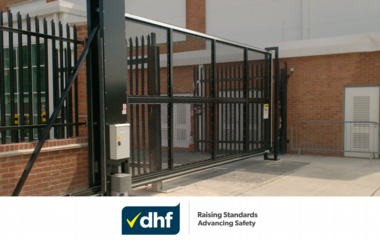Automated Product Maintenance

Safely maintaining powered gates and barriers can be a complex, and often, confusing procedure, with legal ramifications continually ‘front-of-mind’ for the product owner, manager or maintenance provider. DHF’s Senior Training & Compliance Manager, Nick Perkins, offers clarity on a complicated process.
“The first question will often be what constitutes a safe system?” says Nick. “There is a common misconception that if a system was compliant on the day of installation, then it will always be compliant unless modified,” he continues. “Indeed, serious criminal prosecutions within our industry have demonstrated that the test of compliance (reasonable and practicable measures in health and safety law) would relate to current product specific standards.”
The legal position of both parties, which can be a further area of confusion, can be separated as follows:
- Most owners/managers (except domestic owners) have a legal obligation under the Health & Safety at Work Act 1974, to ensure that any systems under their control are safe for anybody who may come into contact with them. This could include members of the public in areas such as car parks or schools. There is a further requirement for owners and managers at workplaces, under the Workplace (Health, Safety & Welfare) Regulations 1992, Regulations 5 & 18, to ensure that gates and barriers in the workplace are maintained and in a safe condition.
- The maintainer has a requirement under the Electricity at Work Regulations to isolate the system for maintenance. There is also a requirement under the Health & Safety at Work Act to ensure that any systems on which they have worked are left in a safe condition.
To manage the process from the maintainer’s perspective, DHF recommends the following four-step process:
- Before going on-site, the maintenance contractor must explain to the client that, as a duty of care to themselves, the system must be taken out-of-service for initial electrical and structural safety checks prior to the actual work or assessment process. If, during maintenance or assessment work, the system proves to fall below an acceptable standard of safety, it will not be put back into service by the maintenance contractor.
- Once on-site, the maintenance contractor must assess the system for safety before starting work, in so far as is possible in its current condition. The maintenance contractor must also assess the extent of work requested to be done by the system manager in terms of its likely impact on the safety of the system. If step two reveals that the system will be safe on completion of the proposed work, then the maintenance contractor can continue with the contracted work. If step two reveals that the proposed work may not result in a safe system, the maintenance contractor must explain all the exposed hazards to the system manager and what additional work (if any) might be necessary to properly diagnose the hazards, for example, it may prove necessary to replace or adjust drive units, control boards, hinges or rolling gear before a complete assessment is possible. In addition, the maintenance contractor must inform the system manager in writing of the necessary measures to make the system safe.
- The maintenance contractor must then request clearance from the system manager to complete both the contracted work and the required safety upgrade work. If the system manager requires the maintenance contractor to only complete the contracted or diagnostic work (some client organisational, procurement, tendering or contractual issues may dictate this), the system cannot be put back into service if it has safety critical defects, and explanation must be given as to how it has been made safe, for example, by explaining where the switch is or how it has been secured against collapse. In this case, it would be reasonable for the contractor to assume that the required safety upgrade work is intended to be undertaken later. The contractor should also inform the system manager in writing, (using an unsafe system notice) that there could be legal consequences in the event of an incident involving the system if it is returned to service in its current state.
- If, on a subsequent visit, the maintenance contractor finds the unsafe system is still in service, the process must be repeated and the system manager re-informed in writing of the potential hazards and consequences. The maintenance contractor must not be the person who puts the system back into service in an unsafe condition at any stage.
“The only reason that an unsafe system is in service is that the owner or manager has elected to keep it in service,” explains Nick. “This might well be in response to other security or safeguarding legal responsibilities that they have, but it should be at their own volition. From a maintainer’s perspective, they are responsible for working safely, informing the client accurately, offering solutions, and always leaving a system in a safe and compliant condition.
“It is vital to remember that in the event of an investigation, any contractor who has worked on the system in question needs to be able to answer the question: what did you do to prevent the incident?”
For further information on guidance for system owners and managers, please visit the DHF website, www.dhfonline.org.uk
13th July 2023
Back to news
